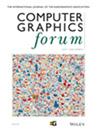Fast and Invertible Simplicial Approximation of Magnetic-Following Interpolation for Visualizing Fusion Plasma Simulation Data
Abstract
We introduce a fast and invertible approximation for fusion plasma simulation data represented as 2D planar meshes with connectivities approximating magnetic field lines along the toroidal dimension in deformed 3D toroidal spaces. Scientific variables (e.g., density and temperature) in these fusion data are interpolated following a complex magnetic-field-line-following scheme in the toroidal space represented by a cylindrical coordinate system. This deformation in the 3D space poses challenges for root-finding and interpolation. To this end, we propose a novel paradigm for visualizing and analyzing such data based on a newly developed algorithm for constructing a 3D simplicial mesh within the deformed 3D space. Our algorithm generates a tetrahedral mesh that connects the 2D meshes using tetrahedra while adhering to the constraints on node connectivities imposed by the magnetic field-line scheme. Specifically, we first divide the space into smaller partitions to reduce complexity based on the input geometries and constraints on connectivities. Then, we independently search for a feasible tetrahedralization of each partition, considering nonconvexity. We demonstrate our method with two X-Point Gyrokinetic Code (XGC) simulation datasets on the International Thermonuclear Experimental Reactor (ITER) and Wendelstein 7-X (W7-X), and use an ocean simulation dataset to substantiate broader applicability of our method. An open source implementation of our algorithm is available at https://github.com/rcrcarissa/DeformedSpaceTet.


 求助内容:
求助内容: 应助结果提醒方式:
应助结果提醒方式:


